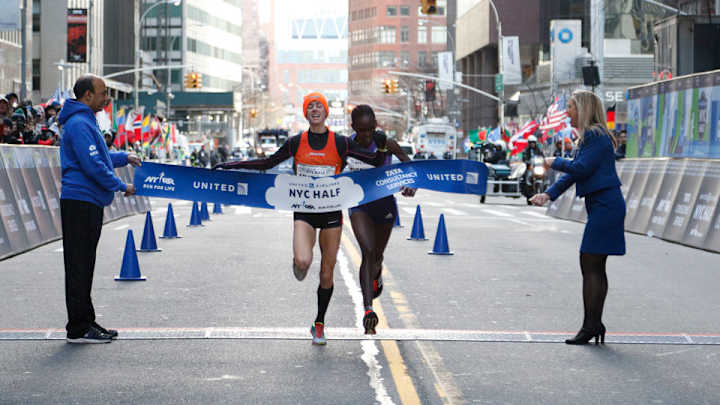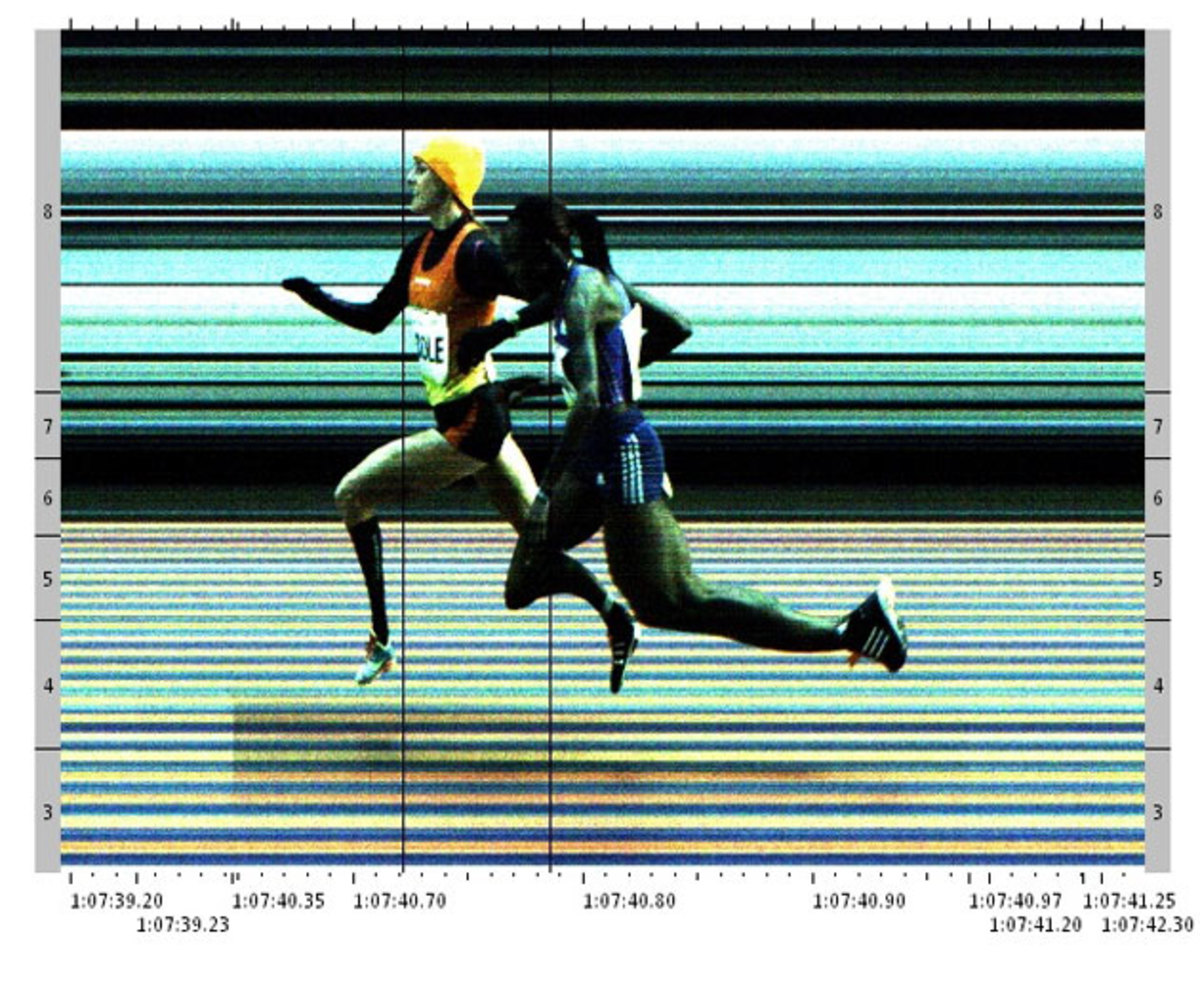Molly Huddle talks NYC Half finish, 2015 heartbreak and her road to Rio

Get all of Chris Chavez's stories as soon as they’re published. Download the new Sports Illustrated app (iOS or Android) and personalize your experience by following your favorite teams and SI writers.
With a ferocious final charge, Molly Huddle edged Kenya’s Joyce Chepkirui by .08 of a second to win last Sunday’s NYC Half Marathon. With a time of one hour, seven minutes and 41 seconds Huddle successfully defended the title she won last year and became the second-fastest American woman ever over 13.1 miles. The finish to the race was dramatic, with both runners straining for the tape shoulder-to-shoulder. Then, just a few strides from the line, Huddle lunged forward and her left arm came up, seemingly blocking Chepkirui at the tape. In what is normally a non-contact sport, Huddle’s action left a shadow of controversy over her sparkling run.
Huddle has gradually improved as a professional since graduating from Notre Dame in 2006, where she was a 10-time All-America. In 2010, she set an American record in the 5,000 meters, running 14:44.76 in Brussels. She has since competed at the 2012 Olympics (11th in the 5,000), lowered her own 5,000 record to 14:42.64 in 2014 and has shown promise in the 10,000 and half-marathon.
Last year, Huddle asserted her dominance on the roads by winning five U.S. titles as well as the 10,000-meter national title on the track. Despite that success, she was best known for finishing fourth in the 10,000 at last year’s world championships after celebrating early and being caught for the bronze medal at the finish by compatriot Emily Infeld.
As evidenced by her strong runs in 2016 at the Millrose Games and NYC Half, Huddle is not giving up an inch any time soon.
SI caught up with Huddle to discuss her success on the roads and her preparation for the 2016 U.S. Olympic Trials and road to the Olympics in Rio.
Chris Chavez:What happened at the end of the NYC Half finish?
Molly Huddle: The response to the race and the finish has definitely been mixed. It has been upsetting to me because I have a lot of respect for Joyce, especially after a great race between us the year before at the NYC Half. It was really just that I was focusing on the line, the lean and getting over the tape as was Joyce, who was running up into my backswing. It was an honest finish between two women competing really hard to win a prestigious race. I officially want to say there was no intent on my part to cheat or obstruct Joyce. I would never do that. I’m not a win-at-any-cost athlete and it’s been gnawing at me that that has been the story that has taken on a life of its own from the last few steps. I feel it’s been distracting me from things this week and it was kind of important to voice what happened rather than ignore it because it was a misunderstood incident.
I know as a professional athlete I’m going to be subject to criticism, as it’s part of the package. But the nature of media in the Internet age has changed through social media and anonymous message boards into something uniquely relentless and can lead even a healthy person to some dark places. Fortunately for me, I have the resources to get over it eventually but it seems like an unhealthy and unnecessary phenomenon.

CC:Did you see her before the finish line and did you know how close she was?
MH: I tried to take the last tangent when I saw it open up at the last minute. From there, we had 150 meters left to go, according to the technical meeting. I just went all-out at that point because I got a half-step lead on the turn. I didn’t know how close she was until my arms went back. I was leaning at that point already so I didn’t even know which side of me she was on. I knew it would be close and I was swinging myself over the line. Afterwards, we were both OK and going through normal post-race ceremonial proceedings with a victory lap, autographs and photographs. Everyone was happy and then things started to blow up on the Internet, when I got home to the hotel. Neither of us was aware there was a perceived controversy until later on.
We were running close to low 67-minute half marathon pace after the first slower mile, which is probably not going to be remembered as much, and was a very good run for both of us—though I know Joyce has run 66 minutes.
(Note: Chepkirui did not mention anything out of the ordinary to New York Road Runners after the finish. All athletes have 30 minutes after the result is made official to file a protest. Chepkirui did not. The race referee did not question the finish result. “We, as race organizers, felt nothing occurred that had a material impact on the finish,” NYRR told SI in an email.)
@nyrr @MollyHuddle Fair finish. Proud of how hard they both ran. Molly & Joyce are class acts & great Ambassadors for our sport.
— Peter Ciaccia (@peter_ciaccia) March 24, 2016
CC: How much of what happened at last year’s World Championships with Emily Infeld nipping you at the finish has played into your hard effort all the way through the line?
MH: I definitely feel that I’ve had more close races than ever recently. I’ve refined my finish to the point where I’ve gotten faster and not dropped with 100 meters left like I used to be. I’m still there at the end. There’s going to be close finishes. I don’t want to get to the point where I’m skittish on the home stretch. I need to practice how to sort that out. Usually in the longer distances, you don’t have photo finishes that often but it’s happening. I’ve come out on both sides of it in the past. I don’t know whether to chalk it up to racing or something that I just need to look into.
CC: It seems like you want to put the NYC Half finish behind you. How much do you still think about last year’s world championship race? What was that flight like back from Beijing?
MH: The flight back was terrible because it just stuck with me for a long time. Honestly, it’s always going to be there and it’s one of the bigger regrets that I have in my running career. That’s something I’ve come to accept. I know it’s going to get talked about and will be attached to my name. It was an accident. It’s not a reflection of arrogance or being an idiot. It was just bad positioning and being unaware. I’ve been thinking about that all year. The [NYC Half] is upsetting because I don’t feel that I made a mistake. I just feel that it was an honest race.
My core values as an athlete are being questioned. I’ve always wanted to compete with respect, honesty and humility for my fellow competitors. Those are the three things that drive and motivate me. For that to be called into question, it’s actually really distracting for me to keep showing up to a starting line proud of what I’m representing. This to me was really hard to see the fallout from.
Usain Bolt: Rio 2016 will ‘definitely be my last Olympics’
CC:What are the early plans for the 2016 outdoor campaign? Is the road racing schedule going to lighten ahead of the trials?
MH: It looks like I’ll run the B.A.A. 5K on the road next month (April 16). The next race will be a track race, which could possibly be a 5,000-meter race the night before the Prefontaine Classic.
CC: Do you feel any difference in fitness or strength coming off the new half-marathon personal best or is it business as usual gearing up for track?
MH: I feel like I must be a little stronger to run under 68 minutes on that course. We did have a good tailwind and Joyce was pushing the pace the entire way. I felt like that made the race a lot faster. I’m looking forward to maybe some better 10K times on the track given I’m a bit stronger.
CC:You’re now the second-fastest at the distance and you’re climbing other all-time American lists. Where do you see your place in U.S. distance running history right now?
MH: I see myself as someone who has run fast, and I’ve improved on my finish at every year at the world championships. I’d like to finish in the top three for a medal position before I retire. I’m someone who is still trying to finish my legacy.
CC:Given there’s hope for a medal and all the news of positive tests in the last few months, how do you think the U.S. can fare at the Olympics and how clean will it be?
MH: I have a lot of hope. Every time a news story comes out, it exposes an ugly side of the sport but it also means that we’re one step closer to getting a little bit cleaner. It’s bad news but it’s good news for the athletes that are clean. I’m hoping that will give me another chance to finish in a medal position. Emily was in great shape by August and was able to finish in the top three and if we can do that again that’s another potential medal. I feel like the U.S. is in a really great spot with some excellent distance talent. If world indoors is any indication of how we can do on a more level playing field, I think the U.S. will do really well.
On to Outdoors: Five American indoor track stars to watch in 2016
CC:Before even getting to Rio. The 2014 U.S. champion, Kim Conley, and 2013 U.S. championship runner-up Jordan Hasay did not race at the U.S. Championships last year. Shalane Flanagan has already made the Olympic team in the marathon, which opens up a spot for someone else to make the Olympic team on the track. How difficult will it be to make the 10,000 meter team?
MH: Eugene is definitely the first focus. Kim is definitely a gamer when it comes to making teams. Emily Sisson [Huddle’s training partner] is running really well under coach Ray Tracey. We have a lot of stars coming out of the NCAA with Molly Seidel [NCAA champion from Notre Dame, Huddle’s alma mater]. It’ll be hard and not something to train through or gloss over. With the IOC qualifying time, being so close to the U.S. Olympic Trials qualifier, pretty much anyone who finishes in the top three will go. You just need to be ready on that day.
• IAAF President Seb Coe: ‘We've got to find as many Usain Bolts’
CC: Your résumé with all of the U.S. titles speaks for itself and you’ve found many races to compete in the U.S. Do you think the dropping of the New York City Diamond League is a blow to American track? Several athletes have been vocal about it.
MH: I was upset. I was planning on running it. I had run it in the past. I hope another event in the U.S. will take its place. I heard news of a street meet and that’s interesting. It takes away a track meet that you prepare for during your track season. Losing a meet with no replacement, I don’t think that’s great. I’d love to see more than one Diamond League in the U.S. and see them promoted better. I thought New York was a great venue and I wish there were more fans there. It’s a great city to race in.
CC:Did you watch the U.S. Olympic Trials Marathon last month?
MH: Yes.
CC:It’s very early at the moment, but given your success with the half marathon thus far, what would say is the likelihood that you could make your marathon debut in the fall after Rio?
MH: I definitely would love to do one this year. I feel like I’m at an age where if I wanted to do one, I need to do it now especially with the learning curve that comes with the marathon. I would say that after the Olympics, I am looking to do one.
